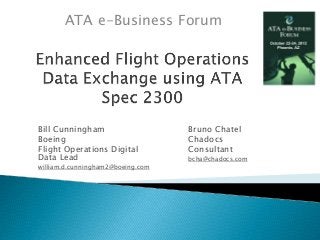
Enhanced Flight Operations Data Exchange using ATA Spec 2300
- 1. ATA e-Business Forum Bill Cunningham Boeing Flight Operations Digital Data Lead william.d.cunningham2@boeing.com Bruno Chatel Chadocs Consultant bcha@chadocs.com
- 2. Each OEM delivers Flight Operations data using proprietary formats ◦ May differ from one airplane program to another program for an OEM ◦ Mix of structured and unstructured formats XML, SGML Published data (e.g. PDF) ◦ Proprietary data models… …and tools ◦ No shared basic concepts
- 3. Need specific/separate systems to manage Flight Operations data for each OEM/program OEM manuals ◦ Airlines often need to customized OEM manuals ◦ Airline also publish in-house manuals (SOPs) that often cross or combine fleets from multiple OEMs Airline manuals may require specific airline proprietary formats/tools Configuration management and other transversal requirements : no opportunity to use same level or technology Industry publishing solutions providers can convert multiple OEM FO data into a single structure, but this is costly and often involves compromise Mixed fleet High cost
- 4. Receive data from OEM ◦ Fleet manual Calculation of revision impacts Add Airline customized data Publication ◦ Fleet manual ◦ A/C manual (single-tail) Deliver to crews ◦ Onboard : EFB, Paper ◦ On-Ground: Paper, Computers, Tablets, Intranet Training A standard exchange model for Flight Operations data will allow airlines complete all these tasks with a single system.
- 5. What is it ? ◦ Common vocabulary ◦ Common data model ◦ Common data types and data organization framework ◦ Common exchange package technology (based on XML) ◦ Each data provider uses the same language to deliver FO data What it is not ! ◦ No standardized manual organization ◦ No standardized authoring philosophy, constraints ◦ No standardized content ! ◦ No standardized publication process ◦ No standardized style sheets
- 6. What do we deliver: Flight Operations data types, manuals ◦ Data-centric approach Data modules are marked-up based on the content, not the organization of the manual ◦ Additional data definitions are provided to organize and publish DM into logic documents
- 7. Flight Operations data will be delivered as a set of XML files ◦ Data Modules Technical content DM Status ◦ Publication Modules Organization for Publication PM Status ◦ Data management XML documents External objects, such as graphics and multimedia are delivered as separate files and referenced in the technical content DMs
- 8. Separate XML fragments Status => metadata related to content ◦ Applicability ◦ Revision data ◦ Metadata (approval/subset info, tdm, qualifications, policy references, data owner…) Different lifecycles Opportunity to exchange only status or content separately (incremental delivery)
- 9. Provisions for complete or incremental exchange Revision data ◦ Status Information New, Changed, Applicability change, Unchanged ◦ Reason for update Technical or Editorial Deleted, Moved, Textual content ◦ Revision marks Add, Modify, Move, Move and Modify Revision data is delivered in the DM Status XML Fragment
- 10. ACT, PCT, CCT : cross reference tables ◦ Based on S1000D ◦ Defines the products (aircraft table) and the conditions (list of Airplane Modifications/Service Bulletins) Applicability statements ◦ Statement that gives the applicability for 1 DM or a specific element Which products (aircraft), with conditions or not ? If needed, associated with a formula of technical criteria ◦ In the DM status Can define inline applicability (using XPATH to address the element in content) Container/alternates ◦ Different DMs of the same subject for different configurations (applicability) are called alternates ◦ Alternates are grouped in “interface” DM called container.
- 11. General purpose ◦ Repositories allowing data factorization, provided as data modules Repository types ◦ Glossary Set of definitions for abbreviations referenced in content ◦ Qualifier (dispatch, avionic contexts) Business qualification of content such as Impacts on performance of a dispatch condition Limitations on landing capabilities due to a dispatch condition Code of data received from avionics systems allowing to index an alert for a procedure ◦ Link target summary Set of resolved links targets information Allows resolution of links to data outside of an exchange package
- 12. Are found in the spec : ◦ Information Layers Three layers are available – Need to Know, Nice to Know, Expert Knowledge ◦ TDM Temporary data module ◦ Major event High priority for a set of data ◦ External applications Opportunity to reference external applications (such as Performance applications) from the content ◦ Subset Identification of a set of data modules, part of a bulletin (OEB, OMB) ◦ Metadata related to a DM Phase of flight, crew qualification, policy references, data owner
- 13. An exchange package is composed of a set of objects ◦ DM (content and status), PM (content and status), External objects (graphics & multimedia) The Exchange Package Status List provides ◦ the package content, with related status ◦ the list of deleted resources Delivery can be Complete or incremental ◦ Only changed resources are delivered
- 14. Common Exchange Interface ATA 2300 OEM A Exchange Pack A/C Program X Exchange Pack A/C Program Y OEM B Exchange Pack A/C Program Z Airline Revision impacts Customization environment Data model Configuration management Publication tools Mixed fleet but… + Single data format + Single environment On ground Consultation tool EFB EFB EFB
- 15. Version 2011.2 Spec + XML Schemas All business requirements for FCOM, MMEL, DDG, AFM, QRH Developed by FOIG ◦ OEM participants ◦ ATA e-Business Program ◦ Airline participants ◦ XML publishing industry vendor participants and consultants
- 16. The group holds quarterly face-to-face meetings Web and phone conferences are held regularly to monitor and progress the work between face-to-face meetings Members are assigned action items to work between meetings New participants are needed and always welcome!
- 17. 2012/2013 : consolidation, proof of concepts ◦ General analysis of all data types ◦ New requirements ◦ Schema Simplification and Consolidation ◦ Spec rewriting/reorganization ◦ Planning for the Future
- 18. Questions? Thank you for attending our session!